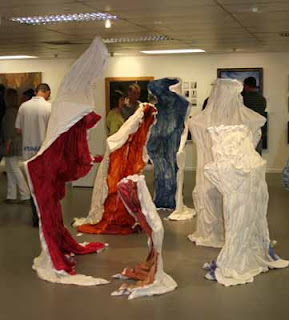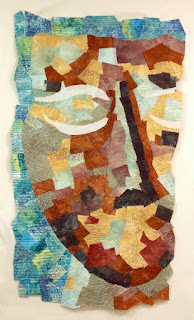I realised the
other day on the middle one’s 10th birthday that it must be 10 years
since I graduated from Goldsmiths. In
some ways it seems like a life time ago since I was studying textiles
there. So much has happened since and
not just in my artwork.
When I visited
Goldsmiths for an Open Day before I became a student, I remember being told
that it took on average 10 years after graduation for the textile student to
get on the right track for their career.
At the time, I thought, surely not – that seems forever! Now, 10 years down the line it seems about
right. Things have finally fallen in
place as to where I should be going and taking control and teaching from home
is exactly what I want to do. It has
taken the 10 years to get to this point.
I don’t think it would have worked any earlier.
An anniversary,
like 10 years, is a good time to look back on what I have been doing. So here are some edited highlights (missing
out the low points!) of the last 10 years.
 |
| Vigilance V by Gillian Cooper |
This was my degree
show work.
 |
| Vigliance VIII by Gillian Cooper |
I almost made
these,
 |
| Shelter by Gillian Cooper at Delta Studios |
...but at the last
minute decided to take advantage of the digital knitting machine as I knew I
would not have access to it later. Some
of these knitted pieces later toured in a Scottish Arts Council exhibition, the
Cutting Edge. I finally made the Shelter
pieces for the Loch Lomond Quilt Show gallery.
They now live in my garage!
 |
| the 37 steps installation by Gillian Cooper at the Changing Room, Stirling |
I was ‘Craft Practitioner
in Residence’ at Duncan of Jordanstone School of Art in Dundee for a number of
months. It was fantastic opportunity to
create a new body of work – the 37 steps, which went on to give me my first
solo exhibition at the Changing Room in Stirling.
 |
| 3 of the 37 steps by Gillian Cooper |
This led on to
creating the Unsung Muses series, which has occupied me for the past five
years. Initially it was shown at the
Festival of Quilts, and this year had a number of outings, including to the
European Patchwork Meeting in France and a couple of solo exhibitions in the
UK.
 |
| Unsung Muses at the European Patchwork Meeting |
Over the past 10
years, I have written for a number of textile publications, given talks to
quilt (and other) groups and started running workshops. The teaching part of my life took a huge step
this year when I converted my home studio into a teaching room and started
running textile classes from home. I can’t
believe how popular the C&G in patchwork and quilting is and the dedication
of the lovely students. It is enormous
fun.
 |
| Facing Time by Gillian Cooper |
Looking at this on
paper, it doesn’t seem that much, but I’ve also had two more children and they
do take up a lot of time – which is great.
We also moved to Scotland. And
how could I forget to mention the PomPom Festival – that really was a bit nuts.
 |
| Balfron PomPom Blossom Festival |
So, not bad for 10
years. My work has greatly developed, in
ways I couldn’t have imagined and at the moment, I am loving playing with and
sharing all different types of surface design.
I’m getting ready to think about the next big art project and spending
lots of time teaching and writing. It
will be interesting to see what the next 10 years lead to.









































